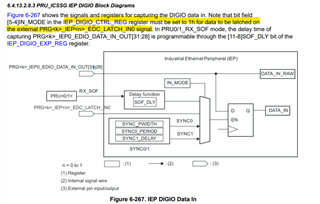Other Parts Discussed in Thread: AM6421
Hello Team,
- As per Profinet document, There is no need for specialized cables or connectors in a PROFINET network. Even if you are using IRT, the communication medium is standard Ethernet. Therefore, you can employ standard Ethernet cables and connectors.
- We gained some insight from the following E2E link, but it's not comprehensive.
PRG1_IEP0_EDC_SYNC_OUT0, (W7) - Required for PTCP/IRT
PRG1_IEP0_EDC_LATCH_IN0, (V7) - Required if Customer needs to synchronise time from external source
PRG1_IEP0_EDC_SYNC_OUT2, (U7) - Required if customer requires Isochronous mode
PRG1_IEP0_EDC_LATCH_IN1 (U13) - PRG1_IEP0_EDC_LATCH_IN1 (U13)
- Are these signals used in special cases or specific to certain optional features of Profinet Class C-CC?
- Are these signals are connected to outside world like PLC or other?
Thanks for your Support.



